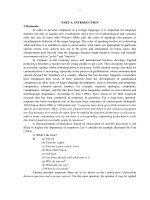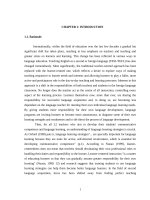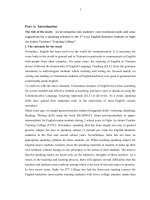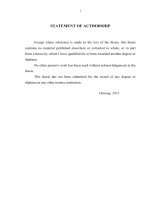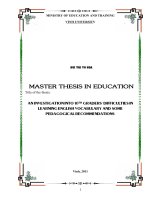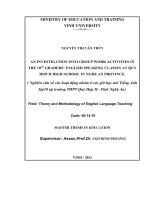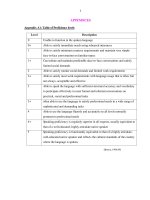An investigation into english word stress mistakes commonly committed by 12th grade
Bạn đang xem bản rút gọn của tài liệu. Xem và tải ngay bản đầy đủ của tài liệu tại đây (1.29 MB, 56 trang )
VIETNAM NATIONAL UNIVERSITY, HANOI
UNIVERSITY OF LANGUAGES AND INTERNATIONAL STUDIES
FACULTY OF POST - GRADUATE STUDIES
***********************
AN INVESTIGATION INTO ENGLISH WORD STRESS MISTAKES
COMMONLY COMMITTED BY 12TH GRADE STUDENTS AT BACH
DANG HIGH SCHOOL IN QUANG YEN DISTRICT, QUANG NINH
PROVINCE AND POSSIBLE SOLUTIONS TO IMPROVE ENGLISH
WORD STRESS LEARNING.
M.A. MINOR PROGRAMME THESIS
Field: English Teaching Methodology
Code: 60140111
HA NOI – 2016
VIETNAM NATIONAL UNIVERSITY, HANOI
UNIVERSITY OF LANGUAGES AND INTERNATIONAL STUDIES
FACULTY OF POST - GRADUATE STUDIES
***********************
AN INVESTIGATION INTO ENGLISH WORD STRESS MISTAKES
COMMONLY COMMITTED BY 12TH GRADE STUDENTS AT BACH
DANG HIGH SCHOOL IN QUANG YEN DISTRICT, QUANG NINH
PROVINCE AND POSSIBLE SOLUTIONS TO IMPROVE ENGLISH
WORD STRESS LEARNING.
M.A. MINOR PROGRAMME THESIS
Field: English Teaching Methodology
Code: 60140111
HA NOI – 2016
DECLARATION
I certify that this thesis, which is submitted to The Faculty of Post – Graduate
Studies for the degree of Master of Arts, is entirely my own work, except where I
have given fully-documented references to the work of others. I have not been
submitted this thesis for assessment for any other course of study.
Hanoi, 2016
Ph
i
ACKNOWLEDGEMENTS
I would like to express my sincerest thanks to my supervisor, Mr. Vo Dai
Quang, for his generous assistance and guidance while I was doing this study. I am
really grateful to him for his precious advice and constant support.
I would also like to send my special thanks to the teachers and students at
Bach Dang high school, who have helped me in providing the materials for my data
collection procedure.
I am also in debt of my lecturers, my friends, my classmates as well as my
colleagues for their invaluable comments and criticism.
Last but not least, I would like to express my deepest gratitude to my beloved
people, my parents, my brother, and my husband who have always encouraged me
to complete this project.
ii
ABSTRACT
In an attempt to have an investigation into word stress mistakes committed
by 12th grade students at Bach Dang high school, Quang Yen, Quang Ninh, the
research objectives set forth for the research were to: (1) investigate English word
stress mistakes commonly committed by 12th grade students at Bach Dang high
school, (2) figure out the causes of these mistakes, (3) and, propose some possible
solutions for both teachers and learners to improve English word stress learning.
The subjects of the study were 78 students at grade 12. The research was
investigated through two instruments: questionnaires for students and students’
voice recording. It is found that students made word stress mistakes mostly in polysyllable words and compound words. Besides, there was a certain difference in the
way students did the written tests and the way students pronounced.
With the investigation into students’ word stress mistakes, the researcher
found out some possible causes of those mistakes. In detail, the mistakes were
supposed to result of both subjective and objective causes. From the findings of the
investigation procedure, the researcher proposed some possible solutions for
teachers, students and book designers to deal with word stress mistakes.
Although the study has offered some insightful findings, like many other
studies, there are some limitations, and therefore, it needs suggestions and
comments from other colleagues and those who are concerned.
iii
TABLE OF CONTENTS
DECLARATION ..................................................................................................... i
ACKNOWLEDGEMENTS ..................................................................................... ii
ABSTRACT .......................................................................................................... iii
TABLE OF CONTENTS ....................................................................................... iv
CHAPTER 1: INTRODUCTION ......................................................................... 1
1.1. Background to the study ................................................................................ 1
1.2. Statement of the problem ............................................................................... 1
1.3. Objectives of the study .................................................................................. 2
1.4. Scope of the study ......................................................................................... 2
1.5. Significance of the study ............................................................................... 2
1.6. Design of the study ........................................................................................ 3
CHAPTER 2: LITERATURE REVIEW ............................................................. 4
2.1. Role of mistakes in language learning ........................................................... 4
2.2. Role of stress in language learning ................................................................ 5
2.3. Theoretical background to the concept “stress” ............................................ 7
2.3.1. Syllables.................................................................................................. 7
2.3.2. Strong and weak syllables ....................................................................... 7
2.3.3. Nature of stress ....................................................................................... 8
2.3.3.1. The loudness ..................................................................................... 9
2.3.3.2. The length ......................................................................................... 9
2.3.3.3. The pitch ......................................................................................... 10
2.3.3.4. The vowel quality ........................................................................... 10
2.3.4. Placement of Stress within the word ...................................................... 10
2.3.5. Some rules for word stress marking ....................................................... 11
2.3.5.1. Proper nouns ................................................................................... 11
2.3.5.2. Monosyllabic words (1 syllable words) .......................................... 11
2.3.5.3. Bi-syllabic words ............................................................................ 11
iv
2.3.5.4. Poly-syllabic words ......................................................................... 13
2.3.5.5. Compound words ............................................................................ 15
2.3.6. Levels of stress ...................................................................................... 15
2.3.7. Weak forms of words (Reducing function words) ................................ 16
2.4. Possible causes of word stress mistakes ...................................................... 16
2.5. Teaching and learning word stress of 12th grade students at Bach Dang high
school................................................................................................................. 19
2.5.1. Word stress lessons designed in the textbook English 12. ..................... 19
2.5.2. Language teaching and learning reality at BachDang high school. ....... 21
2.6. Summary .................................................................................................... 23
CHAPTER 3: METHODOLOGY ...................................................................... 24
3.1. Research questions ................................................................................... 24
3.2. The subjects ............................................................................................. 24
3.3. Research methods .................................................................................... 24
3.3.1. Questionnaire ..................................................................................... 24
3.3.2. Voice recording2 ............................................................................... 25
CHAPTER 4: FINDINGS AND DISCUSSION ................................................. 26
4.1. Findings from the questionnaire .................................................................. 26
4.1.1. Part 1..................................................................................................... 26
4.1.1.1. Students’ attitude towards learning word stress ............................... 26
4.1.1.2. Students’ awareness of the difficulty in stress lessons ..................... 26
4.1.1.3. Students’ degree of certainty in word stress marking ....................... 27
4.1.1.4. Frequency of students’ mistakes in word stress2 ............................. 27
4.1.1.5. Students’ most common mistakes in word stress. ........................... 28
4.1.1.6. Students’ expectation towards the teaching of word stress .............. 29
4.1.2. Part 2..................................................................................................... 29
4.1.2.1. Scores students get in marking word stress. .................................... 29
4.1.2.2. Detail in all lexical items ................................................................. 30
4.2. Findings from the voice recording ............................................................... 31
v
4.3. Cause of mistakes in word stress ................................................................. 33
4.3.1. Influence of mother tongue.................................................................... 33
4.3.2. Inappropriateness in the textbook English 12 ........................................ 34
4.3.3. Lack of teaching and learning facilities ................................................. 34
4.3.4. Students’ lack of motivation and concern .............................................. 34
4.3.5. English examination format................................................................... 35
4.4. Possible solutions to improve English word stress learning. 3 ..................... 35
4.4.1. To teachers ............................................................................................ 35
4.4.2. To students ............................................................................................ 37
4.4.3. To the course book designers ................................................................ 37
CHAPTER 5: CONCLUSION ............................................................................ 39
5.1. Recapitulation ............................................................................................. 39
5.2. Conclusion .................................................................................................. 39
5.3. Limitation of the study ................................................................................ 40
5.4. Suggestions for further study ....................................................................... 40
REFERENCES .................................................................................................... 41
APPENDIX ............................................................................................................ I
vi
LIST OF ABBREVIATIONS
EFL
English as a Foreign Language
ELT English Language Teaching
IPA
International Phonetic Alphabet
L1
A first language
L2
A second language
SLLs Second Language Learners
vii
LIST OF FIGURES
Pages
Figure 1: Students’ attitude towards learning English word stress
26
Figure 2: Students’ awareness of the difficulty in word stress lessons
26
Figure 3: Students’ degree of certainty in word stress marking
27
Figure 4: Frequency of students’ mistakes in word stress
27
Figure 5: Students’ most common mistakes in word stress
28
Figure 6: Students’ expectation towards the teaching of word stress
29
Figure 7: Students’ scores in marking word stress
29
Figure 8: Number of students with incorrect marking
30
Figure 9: Difference between marking in paper and pronunciation in voice
recording
31
viii
CHAPTER 1: INTRODUCTION
1.1. Background to the study
The English language has rapidly become the most popular first foreign language
among Vietnamese people, especially at schools, colleges and universities. For
learners of English, the English language surely brings about a better career
prospect. Needless to say, pronunciation in general, and word stress in particular is
amongst the most prominent aspects that language learners need to learn as an
essential component of their academic practice and later on in their professional
communication, which partially explains why teaching pronunciation has prompted
a good deal of research that covers various aspects of its broad instructional
contexts. Teaching and learning how to mark word stress gets even more
complicated and challenging for both language teachers and students. For many
Vietnamese students, pronouncing a word accurately is a substantial challenge.
They may have little ability of pronouncing since the very first stage of schooling,
and may be very anxious about having to pronounce marked by a tutor.
1.2. Statement of the problem
High school students, generally speaking, cannot realistically achieve academic
success without mastering the skill of pronunciation.
In Vietnam high schools, although English are taught as a major subject, teachers
usually emphasize the mastery of vocabulary and grammatical structures. Students
may be able to understand sentences and a short paragraph correctly, but almost all
of them have difficulties, or are even at a loss when requested to pronounce a single
word, not mention to a whole sentence. In addition, official tests are in written form;
as a result, students have very few actual opportunities to represent their ability of
English orally. Bach Dang high school is not an exception as well. Pronunciation,
especially word stress, seems to be rarely taught in English lessons. When asked,
teachers all agree stress itself appears time consuming and the students’
improvement is difficult to achieve.
1
Being aware of the problem and with the intention of helping students to overcome
difficulties and to perfect their knowledge of English word stress, the researcher
decides to choose the title: An investigation into English word stress mistakes
commonly committed by 12th grade students at Bach Dang high school in Quang
Yen district, Quang Ninh province and possible solutions to improve English word
stress learning for the M.A thesis. It is hoped that the study, to some extent, will
contribute to improving the teaching and learning of English word stress in Bach
Dang high school in particular and English study in general.
1.3. Objectives of the study
The objectives set forth for the research are to:
(1) investigate English word stress mistakes commonly committed by 12th
grade students at Bach Dang high school,
(2) figure out the causes of these mistakes,
(3) and, propose some possible solutions for both teachers and learners to
improve English word stress learning.
1.4. Scope of the study
The study is focused only on the 12th grade students at Bach Dang high school. The
subjects of the study were chosen at random among 78 students of English basic
program. Hence, the study results cannot be true to all Vietnamese learners. That is
to say, the study works well only for teachers and learners who are teaching and
learning at such schools with similar English syllabus or education training or for
the ones who are concerned.
Moreover, due to both limited time and experience, this study only mentions the
mistakes in word stress. Any attempt to study English stress mistakes on other
aspects, such as sentence stress, is beyond the scope of this thesis.
1.5. Significance of the study
The study’s aim is bringing about some benefits for teaching English word stress to
high school students especially the students of Bach Dang high school. When it
comes to foreign language teaching and learning, the study tells about the students’
2
attitude and method in learning English word stress, where they need help and what
sort of help they need. An explicit understanding why mistakes arise can assist in
adjusting teaching techniques.
Besides, for immediate purposes, remedial lessons or exercises can be designed to
help eliminate mistakes. In terms of material designing, the study may assist
designers to understand the nature of mistakes occurring to high school students,
which is useful for them in sequencing and arranging target language items in text
books in such a way helping prevent mistake occurrence as much as possible.
1.6. Design of the study
The research consists of five chapters:
Chapter 1 - Introduction - presents the background and statement of the problem,
the purpose, the scope as well as the method of the study.
Chapter 2 - Literature Review - looks at notion of mistakes and the its roles in
language learning. It discusses some definitions such as syllable and its structure,
nature of stress; word stress marking rules.
Chapter 3 - Methodology - is the core part of the research, which describes research
methods as well as data collection procedure.
Chapter 4 - Findings and Discussion - indicates data analysis result and also helps
teachers and students in high schools overcome difficulties in teaching and learning
English word stress as well as some recommendations for school’s facilities and
course book designers.
Chapter 5 - Conclusion - offers recapitulations, limitation of the research; besides,
gives suggestions for further studies.
3
CHAPTER 2: LITERATURE REVIEW
2.1. Role of mistakes in language learning
Language learning, like any kind of human learning, entails committing mistakes.
According to Lennon (1991) a mistake is “a linguistic form or combination of forms
which in the same context and under similar conditions of production would, in all
likelihood, not be produced by the speakers’ native speaker counterparts". In the
second language teaching/learning process, the mistake has always been regarded as
something negative which must be avoided. As a consequence, in the past, teachers
always adopted a repressive attitude towards it. To that extent, it was considered to
be a sign of inadequacy of the teaching techniques.
During the past fifteen years, however, researchers in the field of applied linguistics
came to view mistakes as evidence for a creative process in language learning, and
it was accordingly seen as a natural result of the fact that since by nature we cannot
avoid making mistakes we should accept the reality and try to deal with them. Little
by little the mistake has been seen from a different point of view being made
obvious that we can learn from our mistakes. Far from being eradicated, mistakes
are, as Selinker (1969) indicates, significant in three respects:
(1) Mistakes are important for language teachers because they indicate
the learner's progress in language learning;
(2) Mistakes are also important for language researchers as they
provide in-depth understanding on how language is learnt;
(3) Mistakes are significant to the language learners themselves as it is
a way learners have to test their hypothesis about the nature of the language
they are learning.
2.2. Role of stress in language learning
Word stress is not used in all languages. Some languages, Vietnamese or French for
example, pronounce each syllable with equal emphasis. Other languages, English
for example, use word stress and pronounce different syllables with more or less
importance.
4
Many studies have shown that stress plays a very important role in English language
production and perception.
Word stress, according to Madeline (1979) “is not an optional extra that can be
added to the English language. It is part of the language”. Fluent English speakers
use word stress to communicate rapidly and accurately, even in difficult conditions.
If, for example, listeners do not hear a word clearly, they can still understand the
word because of the position of the stress
In terms of language perception, it would seem that heavy reliance on information
about stress pattern and the nature of the stressed syllables is a common and an
efficient way of speech comprehension. When listeners mishear a word, it is usually
stress pattern and the nature of the stressed syllable which decide what listeners
think they hear. The stressed syllable information is very important for the listeners
to reconstruct the whole massage. Not surprisingly, when the stress pattern is
incorrect, errors in interpretation occur.
Bansal in “The intelligibility of Indian English” (1966) gave many interesting
examples of misinterpretation when words with initial stress were uttered with
second-syllable stress: “atmosphere” was heard as “must fear”, “yesterday” as “or
study”, “character” as “director” and so on. That is the reason why students’
intelligibility is a matter that all teachers of English should pay much attention to.
Avery and Erlich (1992) and Kenworthy (1987) agreed that all second language
learners will need practice in English word stress. Bai (1994) proposed four
different functions of English stress: distinctive function; highlight function;
rhythmic function; and communicative functions. Stress must be considered from
the perspective of both the speaker and the listener (Taylor, 1996). If the speaker
does not use stress in an appropriate way, the native speakers might find it difficult
to understand words. It also would make the listener misunderstand what the
speaker is trying to say. The listener will not get cues about what words are
important and when the speaker’s thought is finished. The situation could result in
either the speaker or the listener feeling frustrated or embarrassed when the
5
misunderstanding is cleared up, or the speaker might just express the opposite
meaning and unconsciously offend the listener. Hence, “incorrect stress placement
is the major cause if intelligibility problems for foreign learners” (Roach. P.
1983:73). Consequently, stress is not an optional extra, but rather a core part of the
language. Undoubtedly, stress especially word stress is of great importance to one
phonetic ability.
However, it is easy for some English teachers to neglect or forget this aspect of
teaching. Some teachers might lack proper training in stress teaching and
confidence in providing correct models. Much of the research indicates that native
speakers organize English by stress patterns in their brains; they process the sounds
and listen for the stress patterns rather than individual sounds (Brown, 1991; CelceMurcia, Briton, & Goodwin, 1996; Kenworthy, 1987). Yan (1987) also pointed out
that the mastery of stress could help students to enhance their listening
comprehension. If non-native speakers make a stress mistake within a word or
sentence, native speakers might not be able to understand the word or sentence.
Therefore, manipulating the stress patterns of English improves not only
pronunciation, but also the comprehension of spoken English.
At the word level, stress in English is phonemic since the location of the stress
could differentiate the meaning of words. For instance, English uses stress on
different syllables to distinguish the verb “re΄cord” and the noun “΄record”. In
Vietnamese, in contrast, stress is not phonemic and it cannot discriminate the
meaning of a word; it is tone that can contrast meaning of words. The differences
between these two languages may cause problems for Vietnamese learners in
learning English stress. Vietnamese learners will tend to have problems in English
reduction and blending in English everyday speech. They find it difficult to reduce
unstressed syllables and blend words in the same thought group. Thus, their English
might have a staccato rhythm or sound distracting. Moreover, Vietnamese learners
will probably fail to indicate focus, which should be expressed by stress because of
the different ways to manifest information focus (Bai, 1994). Furthermore,
6
Vietnamese learners might use different tones to indicate different lexical meanings.
Hence, stress does not play an important role in Vietnamese communicative speech
and is easily neglected by Vietnamese learners (Trang, 2002).
2.3. Theoretical background to the concept “stress”
2.3.1. Syllables
In general, the different aspects of stress can be described in relation to syllables. In
English, every word is made up of one or more syllables (Jones D.1998:134). The
sequences from: /frɒm/, cause: /kɔːz/ constitute single syllables; doctor: /ˈdɒktə/,
mistake /mɪˈsteɪk/ contain two syllables each; document /ˈdɒkjʊm(ə)nt/, national
/ˈnaʃ(ə)n(ə)l/ contain three syllables, and so on. Phonetically, syllables are usually
described as consisting of a centre which has little or no obstruction to airflow and
which sounds comparatively loud; before and after this centre (that is, at the
beginning and end of the syllable), there will be greater obstruction to airflow and
/or less loud sound (Roach P. 1983:127).
All of the sounds of a syllable are planned together and pronounced together as an
unbroken unit. For this reason, the length of a syllable remains fairly constant, no
matter how many phonemes it includes. The longest part of a syllable is its vowel.
The vowel is longest when being unsurrounded by any additional consonants. With
every consonant added before or after it, the vowel shortens a bit to compensate for
the added elements of the syllable. (Pennington M.C 1996: 129)
2.3.2. Strong and weak syllables
As is discussed above, English words can be made up of one, two or many
syllables. In all words of two or more syllables, one syllable is more prominent,
louder, or more noticeable than the other syllables in that word. This strong syllable
is stressed (accented), and the other weaker syllables are unstressed (unaccented)
(Dauer: 1983)
A strong syllable described in terms of its phonetic characteristics will be the one,
having as its centre, one of the vowel phonemes, but not ∂ (schwa). According to
Jones Daniel, weak syllable on the other hand, can have four types of centre: (i) the
7
vowel ∂ (schwa), (ii) a close front unrounded vowel in the area of i: and ɪ, (iii) a
close back rounded vowel in the area of uː and ʊ, (iv) a syllabic consonant.
When weak syllables containing vowels are compared with strong syllables, we find
the vowels in a weak syllable tend to be shorter, of lower intensity and different in
quality, e.g. in the word “kitchen” /ˈkɪtʃ(ə)n/, the second syllable which is weak is
shorter than the first, is less loud and has a vowel that cannot occur in strong
syllables. In the word “bottle”, /ˈbɒt(ə)l/, the weak second syllable contains no
vowel at all, but consists entirely of the consonant “l”.
Simply, the first syllable of words like “pillow”, “mirror”, and “telephone” is
stressed, that the middle syllable is stressed in “develop”, “apartment”, “precision”
and that the final syllable is stressed in “pollute”, “require”, “perhaps”.
We marked a stress syllable by placing a small vertical line just before the syllable
/ˈfɑːðə/, /ˈbɒt(ə)l/.
2.3.3. Nature of stress
Stress is an important feature of English. Word stress is the special emphasis that
we give to certain syllables in a word. This emphasis is produced by a stronger
chest pulse.
Only words of more than one syllable are marked for word stress. Stressing a word
wrongly can lead to greater misunderstanding than pronouncing phonemes wrongly,
hence, of great importance. “Stress may be described as the degree of force with
which a sound or syllable is uttered….. a strong force of utterance means energetic
actions of all articulatory organs; it is usually accompanied by gesture with the hand
or head or other parts of the body; it involves a strong “push” from the chest wall
and consequently strong force of exhalations; this generally gives the objective
impression of loudness. Weak force of utterance involves weak action of the chest
wall resulting weak force of exhalatory and giving the objective acoustic impression
of softness”. (Jones Daniel, An Outline of English Phonetics, p. 245). According to
Daniel Jones, one or more sounds in a word or a phrase are heard to stand out more
8
prominently than their immediate neighbors; and a syllable is essentially a sound
sequence containing a peak of prominence. If a word or a phrase contains a number
of peaks of prominence, the degrees of prominence are unequal at various peaks. In
other words, some syllables of a word or phrase are perceived more distinctly than
others.
Jones Daniel says that the prominence of a given sound may be increased or
diminished by means of any one of the three sound attributes, length, stress, or
intonation. A common and effective means of increasing prominence is to increase
the stress. In English, increase of stress is generally accompanied by a modification
of intonation and sometimes by an increase of length.
It is important not to confuse stress with prominence. The prominence of a syllable,
according to Jones Daniel is its degree of distinctness. “The term stress refers only
to the degree of force of utterance; it is independent of length and intonation, though
it may be, and often is, combined with these.” (Jones Daniel, An Outline of English
Phonetics, p. 246).
In English Phonetics and Phonology, Roach P. (1983:72, 73) held the view that “all
stressed syllables have one characteristic in common, and that is called
“prominence”. Stressed syllables are recognized as stressed because they are more
prominent than unstressed syllables. Prominence, then, is produced by four main
factors: (i) loudness, (ii) length, (iii) pitch and (iv) vowel quality.
2.3.3.1. The loudness
Most people keep the feeling that a prominent syllable is pronounced louder than
the others. In fact, if in a sequence of identical syllables, one is uttered with the
intensive loudness, it would be heard as stressed syllable. But only with changing
the loudness of one syllable, the speaker will encounter some difficulties and the
perceptual effect of stress is not strong.
2.3.3.2. The length
Among others syllables with the same length, if only one of them is lengthened
intensively, there is quite a strong tendency for that syllable to be heard as stressed.
9
2.3.3.3. The pitch
Every syllable is pronounced on some pitch, it might vary from low pitch to high
pitch. Within a word, for example, if one syllable is noticeably said differently from
the others, it will be recognized as prominent, and of course a stressed syllable.
Therefore, to place some movement of pitch (e.g. rising or falling pitch) on a
syllable is an effective way to produce a syllable with prominence.
2.3.3.4. The vowel quality
A syllable will be considered as a prominence if it includes a vowel that has
different quality from neighboring vowels. Let’s give a nonsense word
“ba:ba:ba:ba” as one example. If the second syllable is replaced by “bi” syllable,
that replacement one will usually be heard as stressed.
In short, a stressed syllable can be recognized thanks to the combination of those
four factors though syllable may sometimes be made prominent by means of only
one or two of them. Many studies such as “The Intelligibility of Indian English” of
Bansal. R.K or “English phonetics and phonology: A practical course” of Peter
Roach have shown that among the fours, the strongest effect is produced by pitch
and length respectively, and then, loudness and vowel quality.
2.3.4. Placement of Stress within the word
The question of the placement of stress at the correct syllable within the word
causes a great deal of difficulty, particularly to foreign learners. English is not one
of those languages where word stress can be decided simply in relation to the
syllables of the word, as can be done in French, where the last syllable is usually
stressed, in Polish, where the syllable before the last is usually stressed or Czech,
where the first syllable is stressed. Many writers have said that “….. English word
stress is so difficult to predict that the best approach is to treat stress placement as a
property of the individual word, to be learned when the word itself is learned.”
(Roach Peter, English Phonetics and Phonology, p.76). In order to decide stress
placement, it is necessary to make use of some or all of the following information:
(i) whether the word is morphologically simple or complex, (as a result either of
10
containing one or more affixes or of being a compound word) (ii) the grammatical
category to which the word belongs. (iii) the number of syllables in the word (iv)
the phonological structure of those syllables. The rules for the placement of word
stress in two and three – syllable words or in compound words are different, as they
are for words belonging to different grammatical classes.
2.3.5. Some rules for word stress marking
2.3.5.1. Proper nouns
Proper nouns are specific names of people, places or things. For example: Jeniffer
Spain, Los Angeles.
The second word is always the one that takes the stress.
2.3.5.2. Monosyllabic words (1 syllable words)
Parviz B. and Mohammad A.S. (2005:107) stated: “Obviously, these words do not
presents any problems because when pronouncing this isolation, they receive the
primary stress on their only syllable”. Normally, the stress of monosyllabic words is
not shown. When part of the sentence, monosyllabic content words are pronounced
with full forms of vowels whereas monosyllabic function words are normally
pronounced with the weak form of vowels (i.e., with /ə / or /ɪ/.)
2.3.5.3. Bi-syllabic words
In An Introduction To Phonetics, Parviz B.and Mohammad A.S. (2005:108)
mentioned that to determine where the stress is in a word with two syllables is a
simple decision: either the first syllable or the second one, never both of them. The
following hints are helpful for the placement of stress in bi-syllabic words:
- To verbs and prepositions: The basic rule is that: when the second syllable of that
word contains a long vowel or diphthong or tripthong; or it ends with more than one
consonant, then the second syllable is stressed. For example:
contain /kənˈteɪn/
insist /ɪnˈsɪst/
away /əˈweɪ/
among /əˈmʌŋ/
11
When the second syllable is a consist of a short vowel and only one (or none)
consonant, therefore, the stress falls to the first syllable. Thus:
open /ˈəʊp(ə)n/
hinder /ˈhɪndə/
under /ˈʌndə/
into /ˈɪntʊ/
The first syllable is also stressed if it includes “/ɒ/”. For example:
follow /ˈfɒləʊ/
borrow /ˈbɒrəʊ/
onto /ˈɒntʊ/
In two-word verbs, when the verb and the particle are not separated (standing side
by side), the normal location of stress for two-word verbs is the on the particle when
occurs at the end of a sentence or phrase like:
pick up /pɪkˈʌp/
drop out /drɒpˈaʊt /
- To nouns and adjectives: To the nouns and adjectives, the rules are quite
different. If the second syllable has a short vowel, the stress will be focused on the
first syllable.
apple /ˈap(ə)l/
tidy /ˈtʌɪdi/
title /ˈtaɪt(ə)l/
money /ˈmʌni/
latter /ˈlatə/
On the contrary, if the final syllable contains a long vowel, the stress will be on that
final one. Thus:
mistake /mɪˈsteɪk/
design /dɪˈzaɪn/
severe /sɪˈvɪə/
asleep /əˈsliːp/
In reflexive pronouns, the last syllable receives stress:
myself /maɪˈself/
themselves /ð(ə)mˈselvz/
Note:
There are many two-syllable words in English that can be pronounced in two
different ways. The stress change also changes the part of speech of the word.
12
This is one aspect of word stress that should be treated as a separate issue. There are
several pairs of two-syllable words function as nouns when stressed on the first
syllable, and as verbs when stressed on the second syllable.
present /ˈprez(ə)nt/ = a gift (noun); non past or future (adjective)
present /ˈprɪˈzent/ = to give something to someone (verb)
2.3.5.4. Poly-syllabic words
According to Parviz B. and Mohammad A.S (2005:109), deciding which syllable to
give stress becomes very complicated when words include more than two syllables.
With poly-syllabic words, the rules of stress placement start to become ever more
arbitrary - with more exceptions than can easily be explained away.
One general hint to remember is that weak syllables never carry stress. Therefore,
any unstressed syllable will reduce its vowel into a weaker one - like /ə/ or /ɪ/.
Another hint is that poly-syllabic function words happen, for the most part, to carry
stress on their final or ultimate syllable:
nevertheless /nev(ə)rðəˈles/
nonetheless /nʌnðəˈles/
Despite the large amount of research done on the subject of stress, it is still one area
of which phoneticians have little understanding. They have, however, developed a
few rules that can be safely used to identify the stress patterns of the majority of the
English poly-syllabic content words:
- Verbs that end in –ate, -ify or –ize receive stress on their third from right
syllables.
ate:
eradicate /ɪˈradɪkeɪt/
evaporate
/ɪˈvapəreɪt/
ify:
beautify /ˈbjuːtɪfaɪ/
/aɪˈdentɪfaɪ/
13
identify
ize: industrialize /ɪnˈdʌstrɪəlaɪz/
recognize
/ˈrekəɡnaɪz/
- Affixes do not change the pattern of stress
The prefixes dis-, il-, ir-, in-, im-, mis-,re-, un-, under-, over-, and the suffix-ly
(used to make adverbs), -er, -ist, -ism usually do not change the pattern of stress:
dis: disappoint, disadvantage
un: unimportant, unnecessary
il: illegal, illiterate
under: underestimate, underachieve
ir: irregular, irrational
over: overestimate, overachieve
in: inaccurate, inattentive
-ly: happily, interestingly
im: imbalance, immaterial
-er: gardener, employer
mis: misunderstand, misbehave
-ist: pharmacist, biologist
re: reactivate, reappraisal
ism: alcoholism, heroism
- Suffixes
o Stress on the suffix
Words that use the suffix ade, aire, ee, ese, eer, que, ette, or oon have the primary
stress actually placed on the suffix.
This applies to words of all syllable lengths.
ade: lemonade, crusade
ese: Japanese, Vietnamese
aire: millionaire, questionnaire
ette: cassette, cigarette
ee: jamboree, guarantee
que: picturesque, physique
eer: engineer, puppeteer
oon: afternoon, balloon
o Stress on the second from the end syllable
The stress is going to be on the syllable right before the suffix. This applies to
words of all syllable lengths.
able: addable, forgettable
ian: comedian, technician
ial: differential, financial
ible: resistible, impossible,
cian: musician, physician
ic(s): characteristic, economics
ery: bakery, scenery
ion: classification, reposition
14
ia: bacteria, victoria
ish: establish, distinguish
ient: ingredient, convenient
osis: hypnosis, diagnosis
ious: mysterious, religious
o Stress on the third from end syllable
The word stress is on the third from end syllable with ones that end in cy, ty, phy,
gy and al.
cy: democracy, accuracy
gy: allergy, apology
ty: clarity, difficulty
al: nautical, magical
phy: geography, photography
2.3.5.5. Compound words
In general, the simple rules for stress in compound words can be also applied, but
they are not extremely reliable in all cases.
- Compound noun
A compound noun is a noun made out of two nouns that form one word. In a
compound noun, the most stress is on the stressed syllable of the first word.
E.g: football (foot + ball)
iceland (ice + land)
- Compound adjectives
A compound adjective is an adjective made of at least two words.
Often, hyphens (-) are used in compound adjectives. In compound adjectives, the
most stress is placed in the stressed syllable of the second word.
E.g: fifteen-minute
old-fashioned
In case words in a compound adjective are one noun and one adjective, the first one
carries word stress.
E.g: carsick
waterproof
2.3.6. Levels of stress
In An Introduction To Phonetics, Parviz B.and Mohammad A.S (2005:101)
emphasized: There are four levels of stress placement: weak or quiet, tertiary or
regular, secondary or louder and primary or loudest.
15
